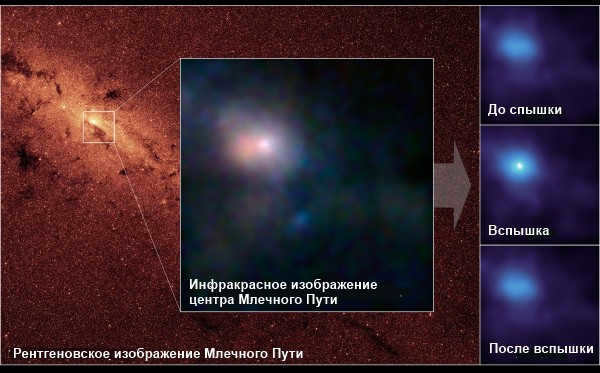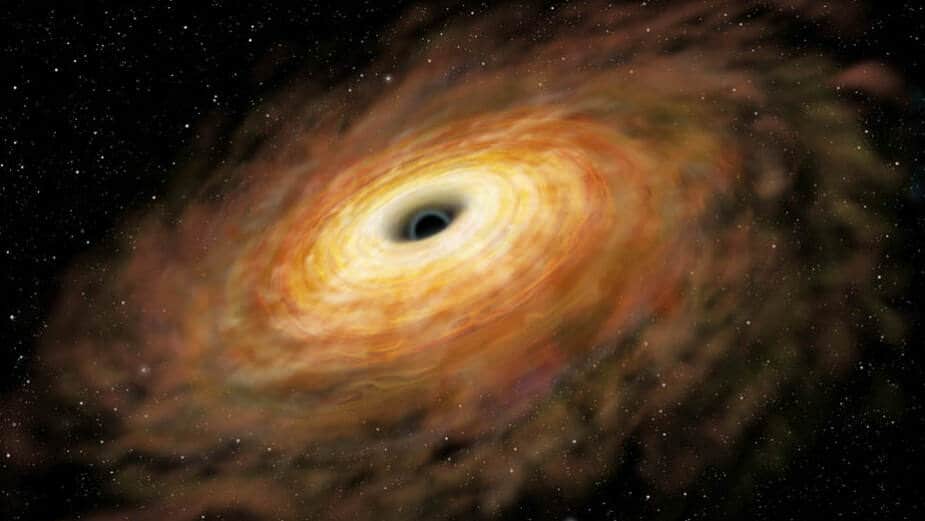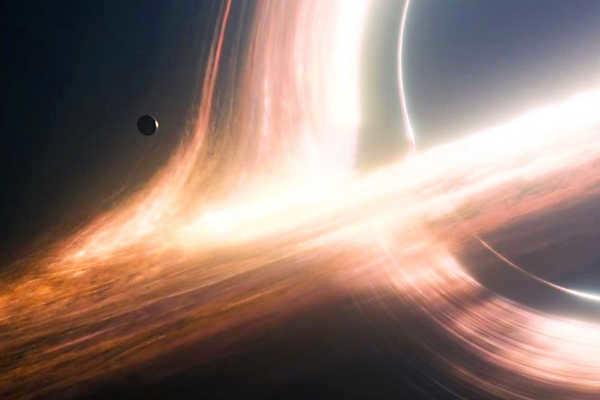
The center of the Milky Way has witnessed the most intense burst of energy ever recorded by astronomers. The supermassive black hole at the heart of our galaxy has unexpectedly become more active, leaving scientists puzzled as to the cause of this phenomenon. In this article, we will delve into this discovery and explore the possibility of the Milky Way momentarily transforming into a lethal quasar.
The awakening of malevolence
Sagittarius A* (Sgr A*), the supermassive black hole located at the center of the Milky Way, is the nearest object of its kind to Earth. This compact and incredibly dense entity emits infrared, X-ray, and radio radiation. Although, according to definition, black holes cannot emit anything themselves (excluding the hypothetical Hawking radiation, which is generated at the event horizon), Sagittarius A* is surrounded by a massive cloud of hot gas that spans six light-years and serves as a source of radio waves. The distance between Earth and this black hole measures 26 thousand light-years, and its diameter is estimated to be around 60 million kilometers (slightly larger than the diameter of Mercury’s orbit).
Observations of Sagittarius A* have revealed that it is a relatively faint entity. Its brightness is nine orders of magnitude lower than the maximum possible brightness (known as Eddington luminosity), but it exhibits continuous variations. Consequently, the analysis of X-ray echoes, which are X-rays reflected by interstellar dust, has allowed us to ascertain that the radio source’s luminosity visible from Earth has experienced fluctuations of five orders of magnitude over the last few centuries. This can be attributed to the dynamic nature of the cosmic environment surrounding the black hole, which includes the presence of stars and other celestial bodies that come into close proximity with Sgr A*, thereby contributing to the process of matter accretion.
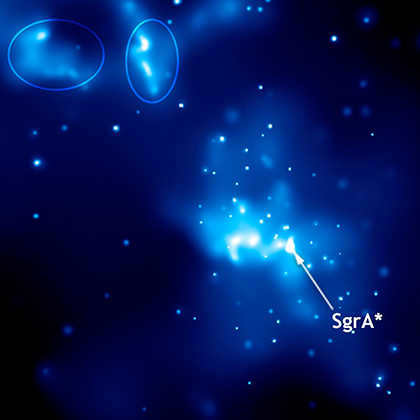
In 2018, a particular celestial object known as S2 came within a distance of fewer than one hundred astronomical units (one astronomical unit, or a.u., represents the average distance between the Sun and Earth) of a black hole. Over the past few decades, astronomers have also documented the approach of two dusty entities named G1 and G2 towards Sagittarius A* – subsequent observations revealed indications of tidal interaction between these objects and the black hole. Based on this evidence, scientists have postulated that both S2 and the two clouds serve as sources of material that is being drawn into the black hole, resulting in alterations in its luminosity.
Surprising Explosion
In the year 2019, a team of international astronomers carried out an examination of the black hole using telescopes located at Keck Observatory on Mount Mauna Kea in Hawaii. The observations took place over the course of four nights, specifically focusing on the near-infrared spectrum. On the 13th of May, the scientists made an unprecedented discovery of an extremely bright flash, which was twice as powerful as any previous record, measuring at 6 millijansky (1 mJan is equal to 10 to the power of minus 29th degree W/(m2-Hz)). Additionally, on the night of the 20th of April, the radiation flux density was also remarkably high, surpassing 99.7 percent of all previously recorded values.
There have been various theories put forth by scientists to account for the unusual occurrence. One potential explanation is that the outbreak is unparalleled due to the limitations of current statistical models, which would need to be revised in order to accommodate this scenario. Essentially, it appears to be a typical behavior for a black hole, one that we were previously unaware of due to incomplete observational data. Another possibility is that the accretion activity of Sgr A* experienced a shift because of an object falling into the radio source, such as matter from S2.
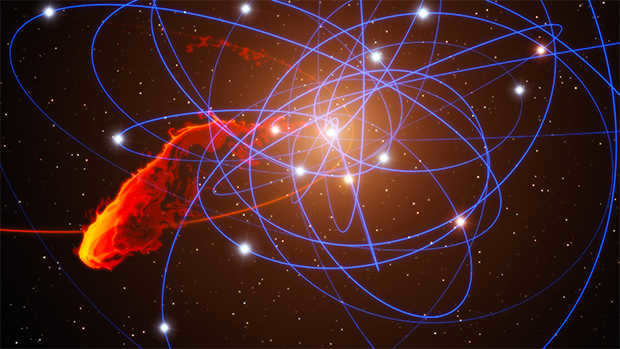
S2 is located in close proximity to the black hole and it revolves around Sgr A* with a orbital period of approximately 15 years. The distance from the black hole to its pericenter, which is the closest point in its orbit, measures around a hundred astronomical units. Due to its close proximity to a massive cluster with a mass exceeding four million times that of the Sun, S2 is able to reach speeds of up to two percent of the speed of light. S2 itself is a massive blue-white giant star with a mass ranging from 10 to 15 times that of the Sun. This type of star could potentially serve as a source of matter that gets accreted by the black hole, resulting in a luminous flash. However, some researchers argue that the impact of such a star would be negligible and that more massive stars are not in close proximity.
A tumultuous history
Presently, the Milky Way is not classified as a Seyfert galaxy, meaning it does not possess an active nucleus (AGN) that releases a tremendous amount of energy. AGNs are also home to supermassive black holes, but unlike Sgr A*, they are surrounded by a luminous accretion disk. This swirling matter becomes heated due to frictional forces, resulting in the emission of radiation across the optical, ultraviolet, and X-ray spectra. The brightness of the disk often reaches the Eddington limit, and it is not uncommon for plasma jets, travelling at speeds close to that of light, to form. NNGs are considered strong contenders for being sources of high-energy cosmic rays.
It is believed that numerous galaxies possessed active nuclei in previous times due to the abundance of cold gas. This is the reason why quasars, which are the most luminous entities in the cosmos, are exclusively found in remote regions of the Universe – the light emitted by them has traveled for billions of years. While supermassive black holes now exist in the central cores of almost all galaxies, not all of them emit sufficient radiation to be classified as active. Additionally, there is evidence suggesting that the Milky Way also had an active nucleus in the past and was once a quasar.
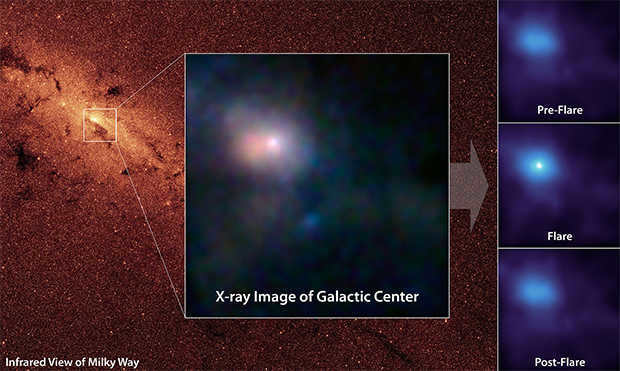
The turbulent early days of the Milky Way are evident in the presence of the Fermi bubbles, two structures that extend from the core in opposite directions along the spiral plane and emit gamma-ray radiation. These structures are believed to have originated from Sagittarius A* during its active phase when it produced jets. However, some scientists propose a different explanation for the origin of the Fermi bubbles, suggesting that they are the result of frequent supernovae occurring in the central regions of the galaxy.
The reflection of X-rays bouncing off interstellar dust reveals that several centuries ago (or more precisely, millennia – it takes 26 thousand years for light from the center of the galaxy to reach us) the brightness of the black hole could have been several hundred thousand times that of the Sun. Another indication of the active nucleus of the Milky Way is the peculiar residual glow of the Magellanic Stream, a collection of interstellar clouds stretching from the Magellanic clouds to the southern pole of the galaxy. Scientists hypothesize that this glow was caused by the passage of a jet emitted by a supermassive black hole. In this scenario, the brightness of the jet would have reached several billion times that of the Sun, and this event occurred only a few million years ago.
In the heart of the Milky Way lies an enormous black hole, with a mass millions of times greater than that of the Sun. Known as “Sagittarius A*” or Sgr A* for short, this supermassive entity engulfs everything within its powerful gravitational pull, including light. Yet, the consumption of matter is just one mechanism by which these celestial behemoths expand to unimaginable sizes, accumulating mind-blowing mass. It is worth noting that when astronomers refer to a black hole as a giant cosmic object, they are typically referring to its immense mass rather than its physical dimensions.
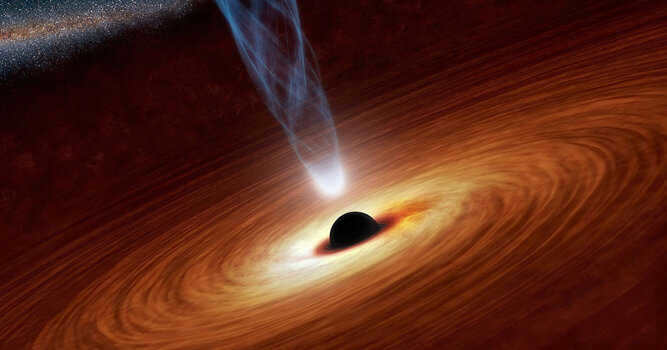
So, the question that naturally arises is: what are the dimensions of various black holes?
Classification of black holes based on their mass
A typical black hole (also known as a “stellar-mass black hole”) is formed when a massive star, weighing more than approximately 8 times the mass of our Sun, reaches the end of its evolutionary cycle. Once the remaining nuclear fuel has been depleted, the star undergoes a phase of rapid gravitational contraction, also known as gravitational collapse, which ultimately leads to a colossal explosion – giving rise to a supernova. The remnants of this explosion can either become a neutron star or a black hole, depending on the mass of the original star. The mass of such black holes can range from a few times the mass of our Sun to tens of solar masses.
However, the issue of where superheavy black holes, like Sagittarius A*, which can be millions or even billions of times the mass of the Sun, come from remains unsolved. Astronomers do know that these massive black holes seem to have a connection to galaxies, specifically the largest ones, as the biggest superheavy black holes have been discovered at the centers of the largest galaxies.
These arguments, along with recent evidence supporting the existence of a predicted class of intermediate-sized black holes (known as intermediate-mass black holes, ranging from hundreds to millions of solar masses), suggest that black holes may grow into supermassive ones over billions of years through the merging of numerous stellar-mass and intermediate-mass black holes.
It is evident that there can be significant variations in the mass of different kinds of black holes, but it remains unclear to what extent they differ in size.
Imagine if the Earth and the Sun were once black holes.
To investigate the dimensions of black holes, let’s start by examining the Earth and the Sun, which are the most extensively studied celestial bodies.
The Earth’s mass is approximately 6×1024 kilograms. Although this may seem enormous to the average person, it is still infinitesimal compared to the mass of a black hole.
Scientists theorize that at the core of a black hole lies a gravitational singularity, a bottomless pit of spacetime with an infinite density. Once an object enters this singularity, it is believed to be trapped there forever. Surrounding the singularity is the event horizon, which marks the outer boundary of the black hole. Within the event horizon, the gravitational pull is so strong that no particle, including light, can escape.
The size of the event horizon, or Schwarzschild radius, is determined by the mass of the black hole. In 1916, the German astronomer Karl Schwarzschild first calculated this radius. For a black hole with a mass similar to that of Earth, the Schwarzschild radius is less than one inch (2.54 cm), about the size of a table tennis ball. In the case of the Sun, the Schwarzschild radius would be slightly less than two miles (3.2 kilometers).
What are the tiniest identified black holes?
As we are aware, detecting black holes can be extremely challenging. This is due to the fact that, unlike stars, they do not emit light as photons cannot escape their event horizon. However, on occasion, a black hole may possess an accretion disk, which is a collection of matter swirling around the black hole. The friction between the layers of this matter causes it to emit light, enabling scientists to observe the black hole. Otherwise, the black hole remains invisible. Furthermore, the presence of a black hole can be inferred by its impact on other celestial objects. For instance, the discovery of the Sagittarius A* object was made after an anomaly in the behavior of seven orbiting stars was detected.
Scientists have made significant discoveries in recent years by using various methods to identify potential black holes. One remarkable find is the smallest black hole currently known to exist, which is located in the GRO J1655-40 double system. In this system, gas from a visible star is drawn towards the black hole, creating an energy flow that powers a microquasar.
Quasars are formed within the intensely bright active nuclei of galaxies, specifically in the central regions where a supermassive black hole is surrounded by a luminous and potent accretion disk. The black hole in GRO J1655-40 is estimated to weigh approximately 5.4 times the mass of the Sun and has a radius of around 10 miles (16 km). By examining these microquasars, astronomers hope to gain a deeper understanding of the potential relationship between the massive black holes hidden in galaxy cores and the smaller accreting black holes scattered throughout galaxies.
Back in 2008, a group of scientists initially reached the conclusion that they had stumbled upon a black hole that was even smaller in size. However, these same researchers later had to amend their findings regarding the mass of this celestial object. It is now believed that any black hole of smaller proportions could have potentially been formed through the merger of two neutron stars, rather than the usual gravitational collapse of a dying star. The Laser Interferometer Gravitational-Wave Observatory (LIGO) managed to detect gravitational waves emanating from a potential neutron star merger in 2017, a mere two years after the first-ever detection of gravitational waves. The emission of gravitational waves during such mergers has provided scientists with a novel method to identify black holes that are located within a distance of 100 million light-years from our planet Earth.
However, the size of a black hole formed from the collapse of a star depends on the mass of the star. The most massive star discovered so far is identified as R136a1 and has a weight 315 times greater than that of the Sun. If a black hole with the same mass were to form from its collapse, it would have a radius of approximately 578 miles (930.2 km). Despite its relatively large size compared to the smallest black holes, this stellar-mass black hole is still much smaller than its supermassive counterparts.
What is the size of intermediate-mass black holes?
Intermediate-mass black holes, which are considered the missing link in the evolution of black holes, lie between stellar-mass black holes and supermassive black holes. Currently, only a small number of potential intermediate-mass black holes have been discovered, including one identified by the Hubble telescope in recent months. These elusive objects are particularly challenging to detect due to their reduced activity when not in close proximity to other space objects, which act as a source of “fuel” for them.
While black holes of intermediate mass have significant sizes, their mass ranges from 100 to 100 thousand solar masses. On the other hand, supermassive black holes can have masses billions of times greater than that of the Sun.
Measuring the size of supermassive black holes
The central black hole in our galaxy, Sagittarius A*, is located 26 thousand light-years away from the Sun and has a radius approximately 17 times that of the Sun. This means that its size is limited to, for example, the orbit of Mercury. Although the black hole in the Milky Way mentioned earlier has a mass of about 4 million solar masses, it is relatively small compared to some of the other supermassive black holes found at the centers of other galaxies.
The Abell 85 galaxy cluster is home to the biggest supermassive black hole ever found. Nestled in the heart of this cluster is the galaxy Holm 15A, which boasts a mind-boggling concentration of matter, totaling around 2 trillion times the mass of our Sun. The core of this galaxy is nearly as expansive as the Large Magellanic Cloud, spanning an impressive radius of 7,000 light-years.
The Mt. Wendelstein Observatory at Ludwig and Maximilian University and the VLT (Very Large Telescope) of the European Southern Observatory have provided information about a cluster of stars located 700 million light-years away from Earth. This cluster is notable for having a black hole that is twice the size of any previously observed. The scientists have determined that the black hole at the center of the galaxy Holm 15A has a massive mass of 40 billion solar masses, which is about two-thirds the mass of all the stars in the Milky Way. This colossal mass gives the black hole a diameter comparable to that of the solar system, making it an object of unprecedented size.
However, the size of the observable universe measures 46.5 billion light years in every direction, thereby leaving astronomers at the initial stages of comprehending the essence of black holes. A mere year ago, the Event Horizon Telescope (EHT), which comprises eight telescopes situated in various locations across the Earth, successfully captured an image of a black hole for the very first time. Furthermore, it is anticipated that the LIGO and Virgo observatories, which examine gravitational waves, will be able to identify approximately 40 binary star mergers annually with the aid of novel technologies, in addition to uncovering black holes and neutron stars situated in close proximity to these celestial bodies. Moreover, with the advent of more advanced telescopes such as NASA’s James Webb Space Telescope (JWST) and the European Space Agency’s Extremely Large Telescope (ELT), which are set to capture their inaugural images within the forthcoming decade, it becomes increasingly difficult to predict the number of black holes – those colossal entities of the cosmos – that will be discovered in the enigmatic depths of outer space in the years to come.
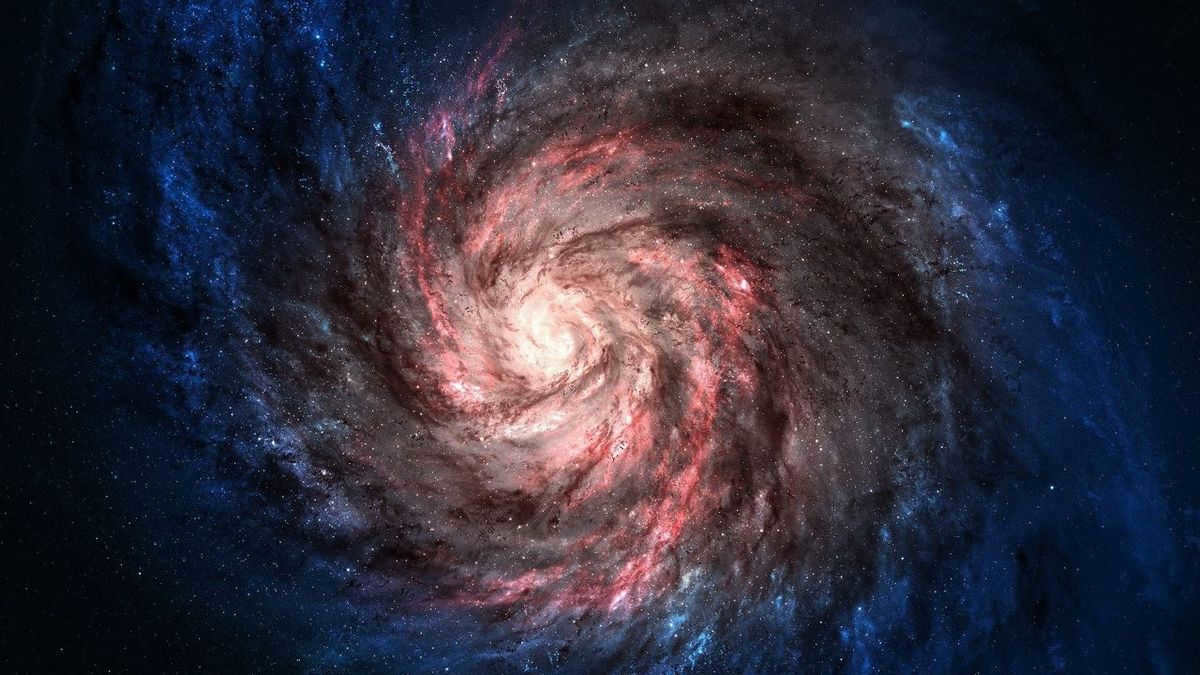

Do you want to hear something fascinating? The center of the Milky Way contains an enormous black hole. And not just any ordinary black hole, but a supermassive black hole that has a mass over 4.1 million times greater than that of the Sun.
This incredible black hole is located just 26,000 light years away from Earth, right in the heart of our galaxy, in the direction of the Sagittarius constellation. As you may know, it has the power to tear apart and consume not only stars, but entire star systems that venture too close to its gravitational pull, thereby increasing its own mass.
Hang on a second, that doesn’t sound fascinating at all, it sounds rather frightening. Doesn’t it?
No need to worry! Actually, you have absolutely no reason to be concerned, unless you have plans to live for several billion years, like me, thanks to the possibility of transferring our consciousness to virtual reality.
Could the Milky Way be devoured by this black hole?
Related articles:
The detection of the supermassive black hole (SBL) located in the heart of the Milky Way, much like the discovery of SBLs in nearly all other galaxies, is one of the most fascinating findings in the field of astronomy. It is a discovery that, while providing answers to some questions, also raises new ones.
During the 1970s, astronomers Bruce Balick and Robert Brown stumbled upon a highly concentrated source of radio emissions originating from the exact center of the Milky Way, within the Sagittarius constellation.
They named this source Sgr A*. And yes, the asterisk symbolizes its “spectacular” nature. You may think I’m joking, but I assure you, I am not.
Back in 2002, scientists made an incredible finding – stars were observed to be zooming past this particular entity in extremely elongated orbits, similar to comets orbiting the Sun. Just think about the sheer mass of our Sun. It would require an immense and tremendous force to change its direction!
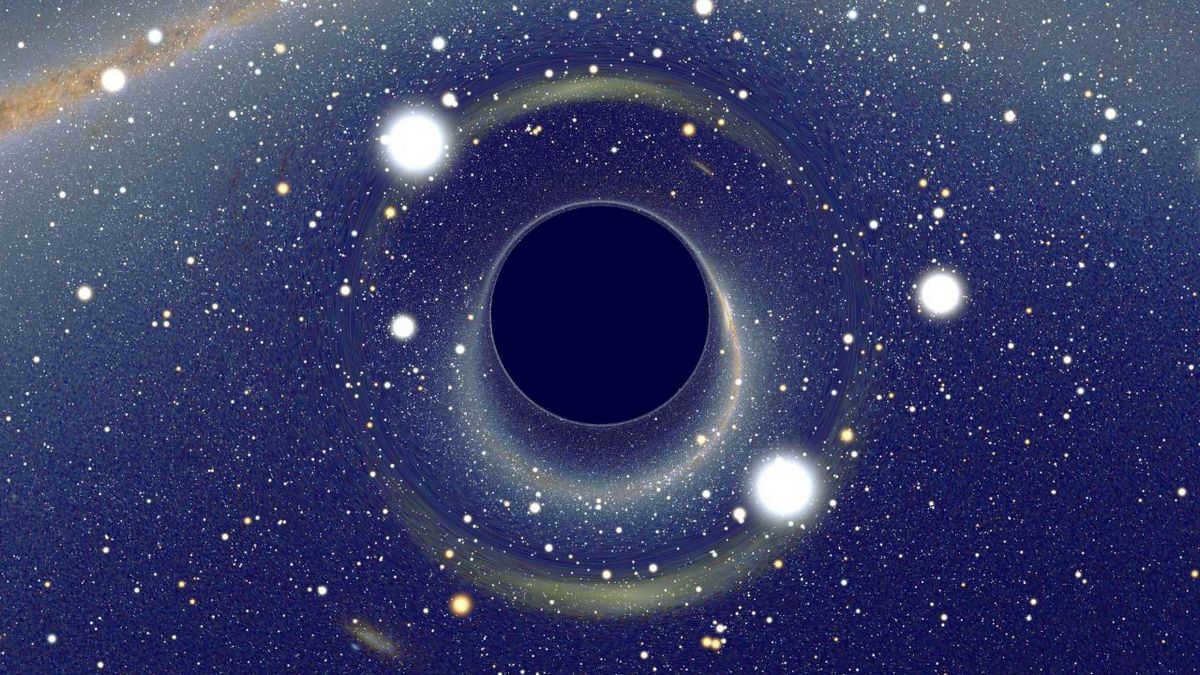
Only black holes have the ability to accomplish such a feat. In our scenario, this particular black hole possesses a mass that is millions of times greater than that of our Sun – it is classified as a supermassive black hole. The identification of the supermassive black hole situated at the center of our galaxy led astronomers to the realization that black holes exist at the core of every galaxy. Moreover, the discovery of supermassive black holes has provided a solution to a fundamental question in the field of astronomy: what exactly is a quasar?
It has been determined that quasars and supermassive black holes are essentially one and the same. Quasars represent black holes that are actively absorbing matter from the accretion disk revolving around them. However, should we be concerned about our safety?
No, not in the immediate future. The black hole situated at the heart of our galaxy, the Milky Way, is located a staggering 26,000 light years away. Even if it were to transform into a quasar, consuming nearby stars, it would take an incredibly long period of time for us to actually observe any noticeable effects.
A black hole is an immense entity that occupies a relatively small portion of space. Interestingly, if we were to substitute the Sun with a black hole of the exact same mass, the consequences would be negligible. Specifically, the Earth would continue to travel along its current orbital path for billions of years, simply encircling the black hole instead.
This same principle applies to the black hole situated at the center of the Milky Way. It doesn’t function like a vacuum cleaner, pulling matter inward. Instead, it serves as a gravitational anchor for a cluster of stars orbiting around it.
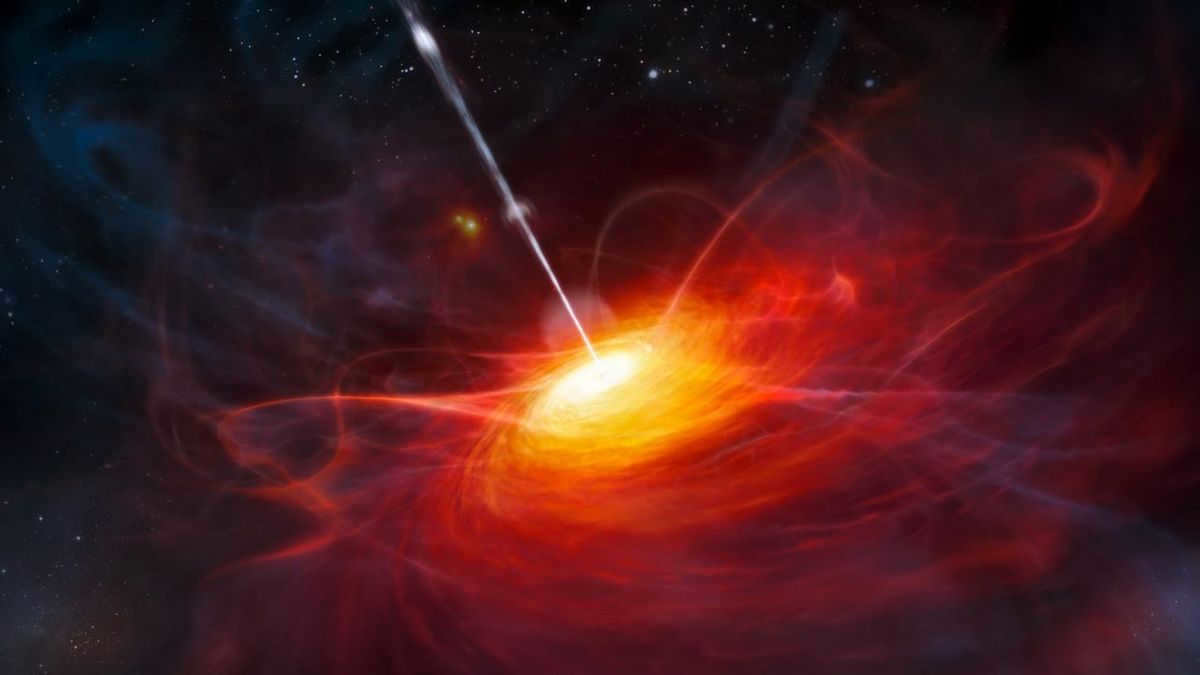
In order for a star to be engulfed by a black hole, it must be moving towards the black hole’s direction of motion. It needs to cross the event horizon, which is approximately 17 times larger than the diameter of our sun. If a star gets close to the event horizon but does not cross it, it will likely be torn apart, although this is a rare occurrence.
The problems arise when these stars interact with each other, leading to changes in their orbits. A star that has peacefully orbited for billions of years can be disrupted by another star, causing it to deviate from its original path. However, such interactions are infrequent, particularly in the outskirts of our galaxy where we are located.
In the distant future, the primary threat lies in the inevitable collision between the Milky Way and Andromeda galaxies. This cataclysmic event is projected to occur in approximately 4 billion years, resulting in the formation of a completely new galaxy, which scientists may dub “Mlecomeda”. As a consequence, an influx of numerous new stars will come into contact with one another, creating a spectacular celestial spectacle. Simultaneously, previously stable stars will undergo significant changes in their orbital paths. Furthermore, the merger will introduce a second black hole into the newly formed galaxy. The black hole in Andromeda is estimated to be a staggering 100 million times more massive than our Sun, making it an enticing target for stars seeking their ultimate demise.
Will our galaxy be devoured by the black hole?
In the coming billions of years, Mlecomeda will experience more and more galaxy collisions, resulting in chaos and destruction. Although the sun will cease to exist in approximately 5 billion years, we won’t have to worry about that future. Well, maybe I will, with my everlasting virtual consciousness.
Once Mlecomeda consumes all the neighboring galaxies, the stars will have an unlimited amount of time to interact with each other. Some will be expelled from the galaxy, while others will be absorbed by a black hole.
However, many others will remain unharmed, patiently awaiting the moment when the supermassive black hole eventually evaporates.
Therefore, the black hole located at the center of the Milky Way is entirely secure. Throughout the remaining lifespan of the Sun, it will not engage with us in any of the aforementioned manners, nor will it consume more than a mere handful of stars each year.
Salutations, I am the creator and overseer of the UniverseTodayRu website. My passion lies within the realms of astronomy, physics, and mathematics. In 2010, I completed my studies at the Pushkin BrSU Faculty of Physics and Mathematics. To facilitate my observations and photography, I rely on the Sky-Watcher BK 909EQ2 and the Canon EOS 1100D. During my leisure time, you will often find me gazing up at the stars, contemplating the mysteries that lie beyond. In addition to the exact sciences, I hold a keen interest in all things pertaining to software and information technology.
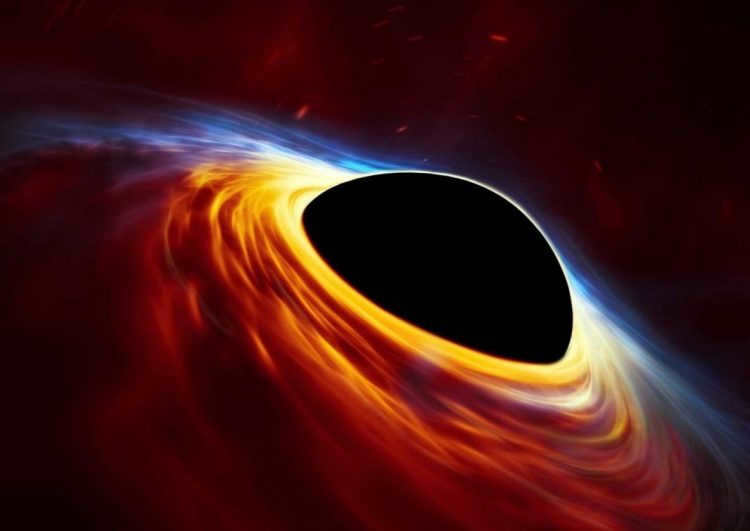
- The celestial objects of the cosmos
A black hole of immense size – refers to a black hole that possesses a mass ranging from 105 to 1011 times that of the sun. These supermassive black holes can be found residing at the core of various galaxies, such as the Milky Way.
These supermassive black holes serve as captivating entities within the Universe. They act as pioneers, showcasing the extreme manifestations of various forces and phenomena, while also becoming the focal point of numerous phenomena. They exhibit a significant range in terms of their size, with the largest ones being billions of times more massive than our Sun. The notion that a supermassive black hole exists at the center of every galaxy has been widely accepted for many decades.
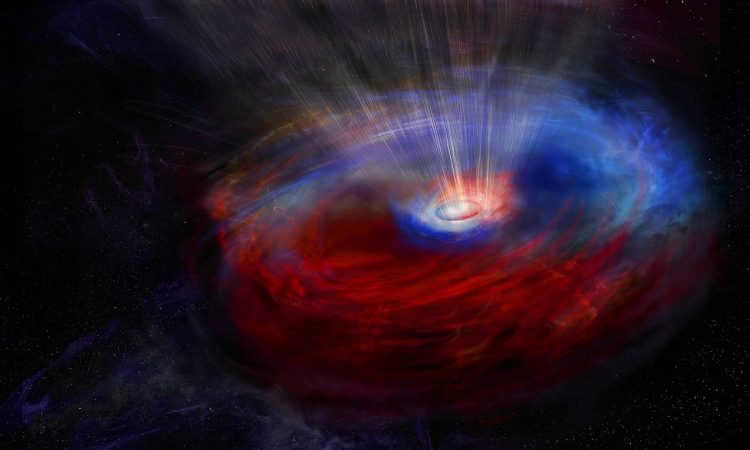
Supermassive black holes possess unique characteristics that differentiate them from smaller black holes:
- Supermassive black holes can have an average density that is exceptionally low, sometimes even lower than the density of air.
- Due to the significant distance between the central singularity and the event horizon, the tidal forces near the event horizon are much weaker for supermassive black holes. Consequently, a hypothetical astronaut journeying towards the center of a black hole would not experience the effects of extreme tidal forces until they delve deep into it.
Development of supermassive black holes
Supermassive black holes vary from black holes originating from stellar-mass black holes in terms of their immense mass and potentially in their formation process. A stellar-mass black hole is created through the collapse of a massive star (greater than 3 solar masses), whereas the precise method of formation for a supermassive black hole remains a mystery.
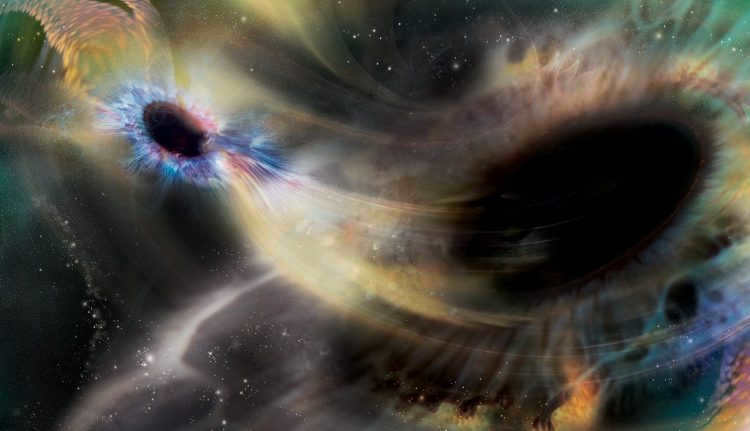
There are multiple hypotheses regarding the formation of supermassive black holes, but none of them have been definitively proven:
- They could be formed by the accumulation of mass in ordinary black holes in regions of the Universe that are rich in dust and gas.
- Another possibility is that they originate from hypothetical medium-mass black holes.
- They may also emerge directly from large amounts of gas and dust.
Medium-mass black holes are extremely rare and there are only a few potential candidates for this type, which contradicts the expected numbers of their supposed supermassive descendants.
In February 2017, a study discovered the presence of intermediate-mass black holes at the center of the massive cluster known as 47 Toucan.
In 2016, there were indications that a supermassive black hole may have been observed directly from immense gas clouds, suggesting the birth of such a black hole in the early universe.
Supermassive black hole activity
Most giant black holes remain quiet and undetectable. However, a small portion of them are voracious eaters, consuming matter in a noisy and conspicuous manner. The intense gravitational pull causes dust and gas to spiral into these black holes, emitting a significant amount of radiation across the electromagnetic spectrum.
The Swan A galaxy, which is located 600 million light-years away, contains an active black hole at its center. This galaxy is the closest to us with such an active feature.
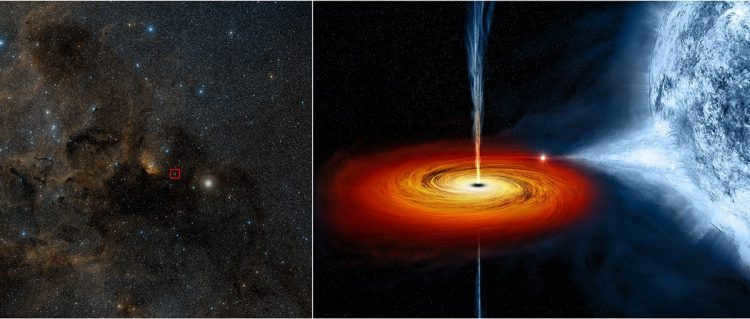
The scientific community is naturally very interested in this. Recently, a study was conducted to investigate how active galaxies like Swan A create doughnut-shaped gas and dust formations known as “torso”.
Using advanced camera technology, researchers were able to detect the infrared radiation emitted by the torus surrounding the galaxy for the first time. This data was then utilized to monitor the magnetic field behavior of Swan A.
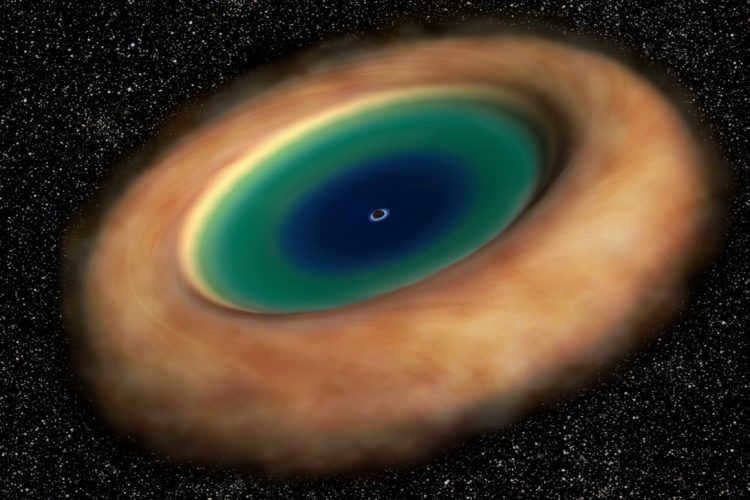
Previously, astronomers primarily focused on the gravitational effects of black holes, but now they have discovered that electromagnetism also plays a significant role. This study has shed light on the relationship between black holes and magnetic fields, and astronomers are eager to further explore this connection by studying Swan A and other galaxies, both active and inactive.
Furthermore, this research may provide insights into why only a small fraction of supermassive black holes exhibit active behavior.
The biggest supermassive black holes
Here are some of the largest black holes that have been measured with known masses, at least to an order of magnitude. While this list is not exhaustive, it provides a glimpse into the immense complexity and vastness of our universe.
The supermassive black hole at the heart of the Phoenix cluster.
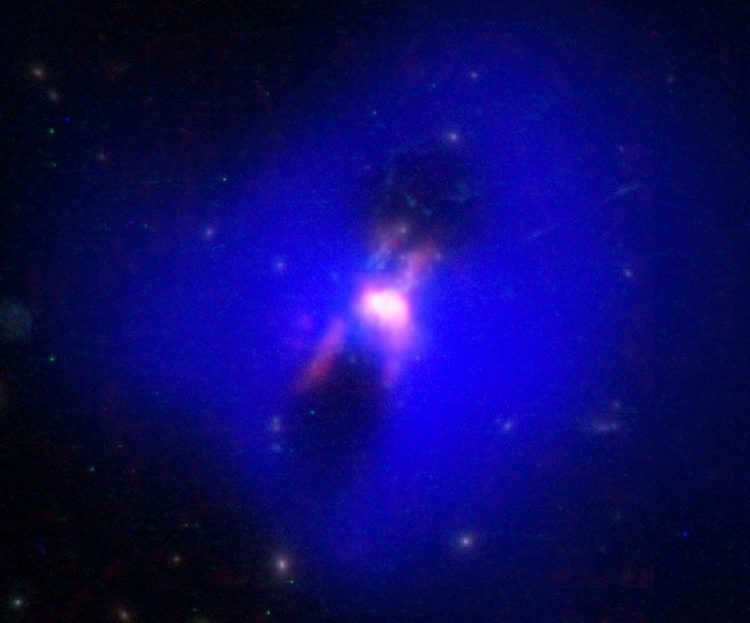
The Phoenix Cluster is renowned as one of the most colossal clusters ever discovered, primarily composed of enigmatic dark matter and the intra-cluster environment. At the heart of this cluster resides an immensely massive black hole, which injects copious amounts of energy into the surrounding system. Experts estimate its mass to be a staggering 20 billion times greater than that of the Sun, with its event horizon extending across approximately 118 billion kilometers.
Through meticulous analysis of Chandra data and comprehensive observations across various wavelengths, scientists have ascertained that this black hole is undergoing rapid growth, devouring matter at a rate equivalent to 60 times the mass of the Sun annually. However, due to its already monumental size, this growth rate is unsustainable and will ultimately cease within a mere 100 million years.
NGC 4889
can be rephrased as
NGC 4889
is another name for NGC 4889.
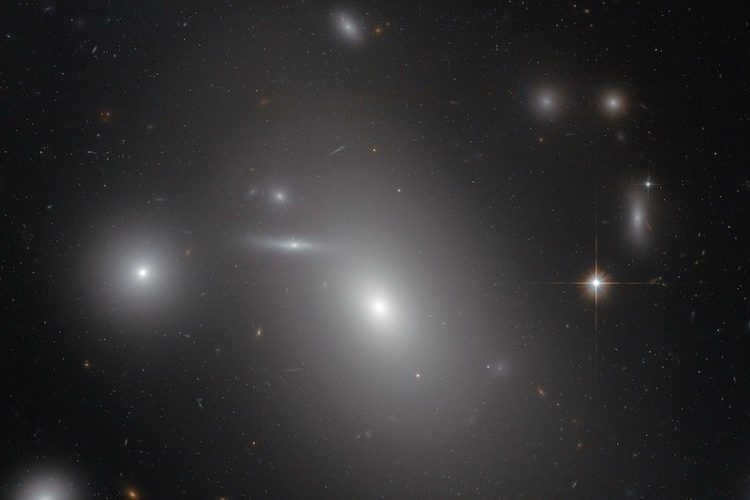
The galaxy NGC 4889, located near the center, shines the brightest.
Discovered in 1785, NGC 4889 is the most luminous galaxy in the northern part of the coma cluster. It sits at an average distance of 308 million light-years away from Earth.
At the heart of NGC 4889 lies one of the largest black holes in existence. This supermassive black hole, which is nearly 5,200 times more massive than the central black hole in the Milky Way, heats up the intracluster environment due to the friction generated by falling dust and gases. It has a weight of about 21 billion solar masses. The event horizon of this black hole spans from 20 to 124 billion kilometers wide, which is equivalent to 2 to 12 times the diameter of Pluto’s orbit.
The current state of NGC 4889 is one of dormancy, with stable stars still present in its vicinity. Nevertheless, the ionized surroundings detected by the Hubble Space Telescope imply that this supermassive black hole, known as APM 08279 + 5255, could have once been an active quasar billions of years ago.
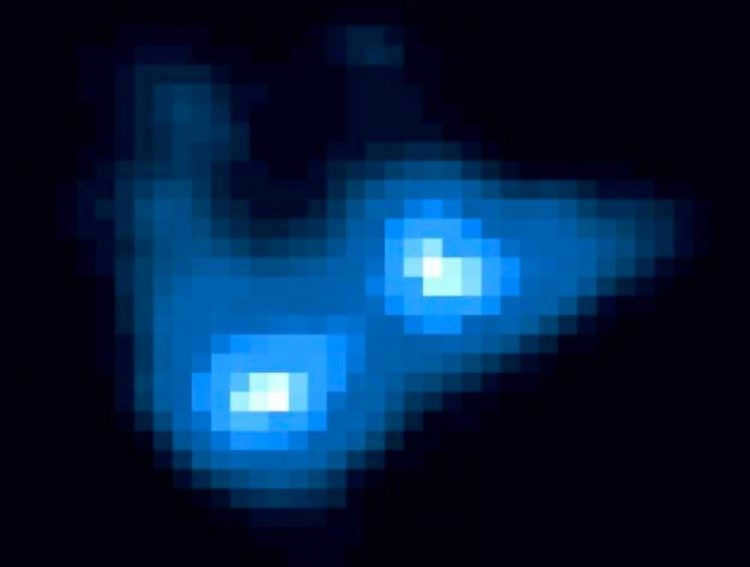
Back in 2002, when examining Chandra observations, it was revealed that gases were being carried away from the supermassive black hole that powers the quasar APM 08279 + 5255. These gases were moving at incredible speeds, reaching up to 40% of the speed of light. The quasar is situated in the constellation Lynx and possesses a brightness that is equivalent to one quadrillionth of the Sun’s brightness. It emits light across a wide range of wavelengths and has become one of the most extensively studied celestial objects in the distant universe.
During the past ten years, scientists have also made a remarkable finding regarding APM 08279 + 5255 – it contains an astounding amount of water, enough to fill Earth’s oceans over 100 trillion times.
NGC 6166
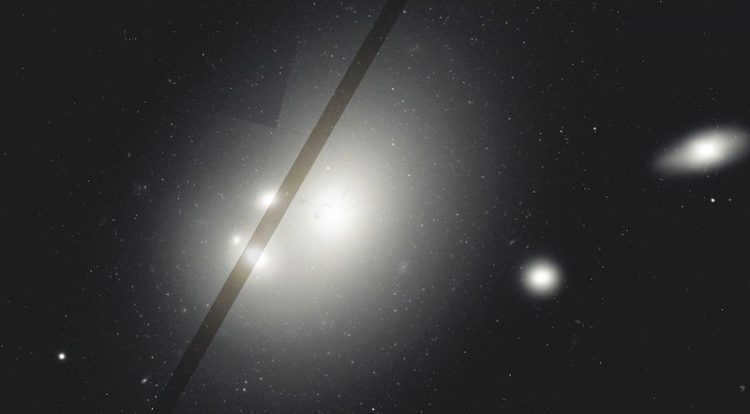
NGC 6166 is an exceptionally bright elliptical galaxy, situated 490 million light-years away in the Hercules constellation. It is noteworthy for its high X-ray emissions. The galaxy is surrounded by approximately 39,000 globular clusters, which indicate a seamless integration of NGC 6166’s halo with the intracluster medium.
The core of this galaxy hosts a supermassive black hole with a mass that is 30 billion times greater than that of the Sun. This colossal black hole devours around 200 solar masses of gas annually, generating enormous relativistic jets. Additionally, there is speculation among scientists that the galaxy’s center may also harbor multiple O-type stars. These stars are a rarity, characterized by their blue-white hue and temperatures exceeding 30,000 Kelvin.
H1821 + 643
Rewrite the text, making it unique, using the English language and preserving the HTML markup:
H1821 + 643
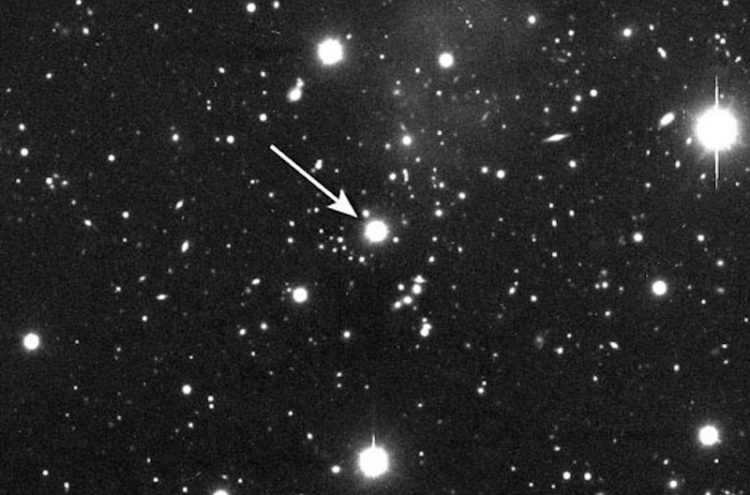
H1821 + 643 is a highly luminous quasar that can be found in a massive cluster with a significant cooling flux in the Dragon constellation. In the year 2014, scientists made the remarkable discovery of H1821 + 643, identifying it as one of the largest black holes ever observed and accurately determining its mass, which is equivalent to a staggering 30 billion solar masses. This black hole has an event horizon width of 1150 astronomical units (with 1 astronomical unit being approximately 150 million kilometers), and its average density measures at 22 grams per cubic meter, which is actually lower than the density of Earth’s atmosphere.
IC 1101
can be rephrased as “The object called IC 1101” or “The astronomical entity IC 1101”.
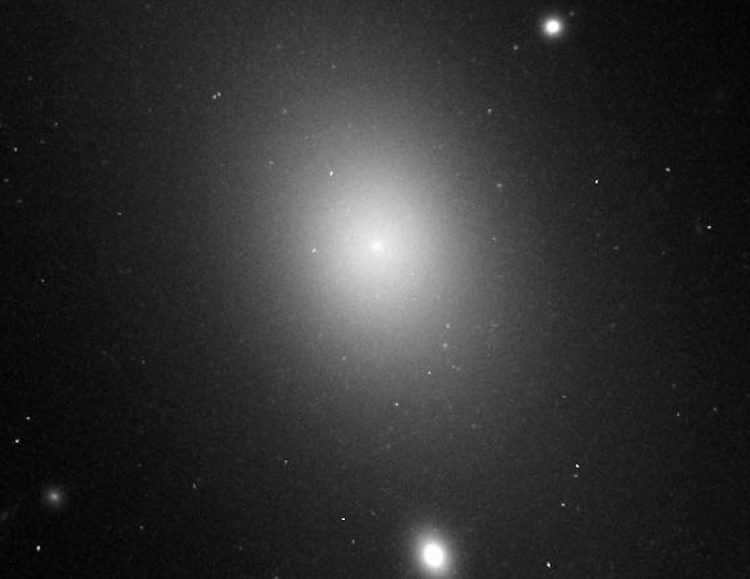
IC 1101, a galaxy of immense size and brightness, is home to a supermassive black hole at its core. This black hole has a mass that is 40 to 100 billion times greater than that of the Sun. Situated 1.04 billion light-years away from Earth, IC 1101 is an elliptical galaxy. Its enormity is evident in its mass, which is estimated to be around 100 trillion stars. Furthermore, this galaxy extends an impressive 2 million light-years from its central point.
Similar to other galaxies of significant size, IC 1101 boasts a substantial population of metal-rich stars. Some of these stars are believed to be around 11 billion years old and are characterized by a striking golden yellow color.
S5 0014 + 81
Please rephrase the text, making it unique, using English language and preserving the HTML markup:
S5 0014 + 81
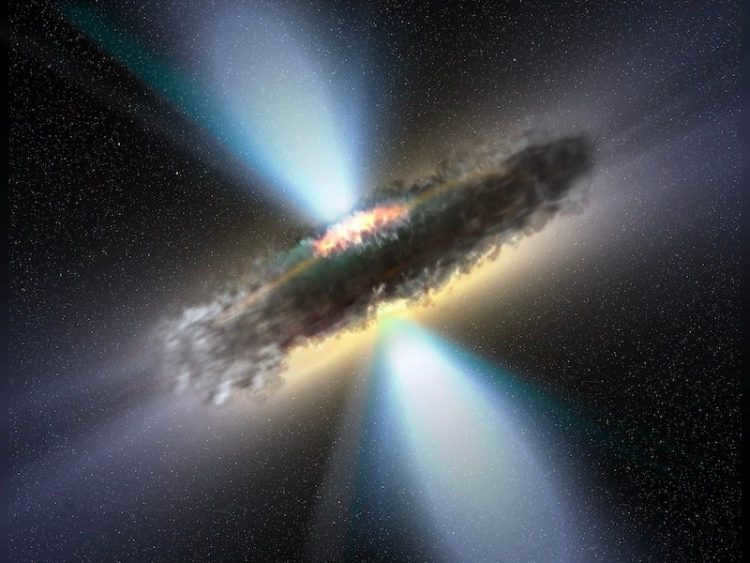
The most powerful form of active galactic nuclei is the blazar situated in the high declination area of the constellation Cepheus. This blazar is located at a distance of approximately 12.07 billion light-years away from our planet. It is currently recognized as the 6th most luminous quasar ever discovered, emitting a brightness that exceeds 10,41W.
To give you some perspective, its luminosity is 25,000 times greater than the combined brightness of all the stars present in the Milky Way galaxy.
Holm 15A
can be rephrased as
The galaxy known as Holm 15A
.
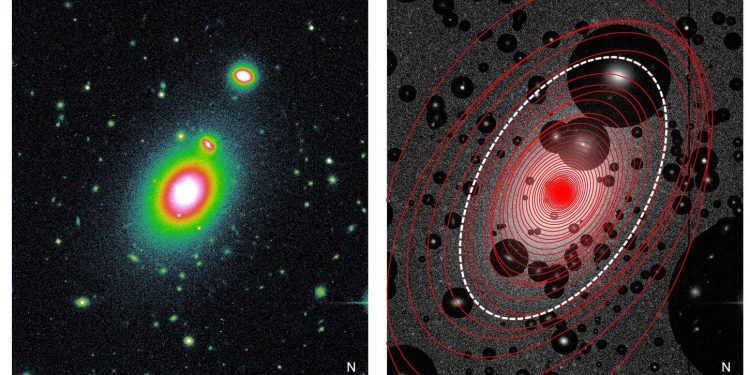
This specific area in the vast expanse of space-time can be found within the galaxy known as Holm 15A, situated approximately 700 million light years away from our planet Earth. Within Holm 15A, there is an extremely massive black hole that serves as the central focal point for a cluster of galaxies called Abell 85 in the Kita constellation, making it the most weighty region of space-time ever discovered.
The Abell 85 cluster, where Holm 15A is located, comprises of more than 500 individual galaxies.
Astrophysicists have successfully estimated the extraordinary mass of this particular black hole for the very first time, revealing that it is a mind-boggling 40 billion times heavier than our Sun, multiplied by 40 billion.
This groundbreaking research was conducted by a team of German scientists hailing from the esteemed Munich Observatory and the Max Planck Institute for Extraterrestrial Physics.
“For the first time in history, astrophysicists have managed to determine the mass of the black hole by “weighing” it. This groundbreaking measurement was conducted using the MUSE spectrograph on the VLT telescope, which boasts the largest mirror area of any telescope on Earth.”
Scientists believe that supermassive galaxies like Holm 15A form when two or more smaller galaxies merge. During this process, the gravitational interaction from the center of the newly formed galaxy causes stars to be ejected into radial orbits, creating a black hole in their place. Astrophysicists have concluded that with each subsequent merger, the black hole gains additional mass.
TON 618
can be paraphrased as “TON 618 is a celestial object.”
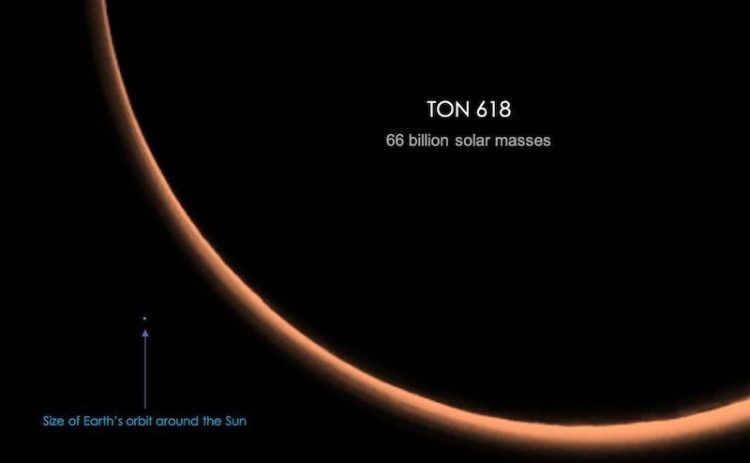
TON 618 is an incredibly bright quasar situated 10.37 billion light-years away from our planet.
It harbors the most gigantic black hole ever recorded, with a mass 66 billion times larger than that of our Sun.
Discovered for the first time in 1957 during a survey of faint blue stars that are not located within the Milky Way’s plane, TON 618 was later identified as a quasar through a more extensive radio survey conducted in 1970. It is believed that TON 618 consists of an accretion disk composed of extremely hot gas orbiting a massive black hole situated at the core of the galaxy. The quasar is so luminous that it surpasses the brightness of the rest of the galaxy.
Indeed, it is among the most brilliant entities in existence, boasting a luminosity of 4 × 10 40 watts, which is equivalent to 140,000 billion times the magnitude of the sun. Due to the rapid movement of gas within the accretion disk, clocking in at approximately 7000 km/s, this black hole produces an extraordinarily potent gravitational force. Furthermore, the event horizon of a black hole of such immense proportions would encompass a diameter of 2600 a.u.
Dwarf galaxies hosting supermassive black holes
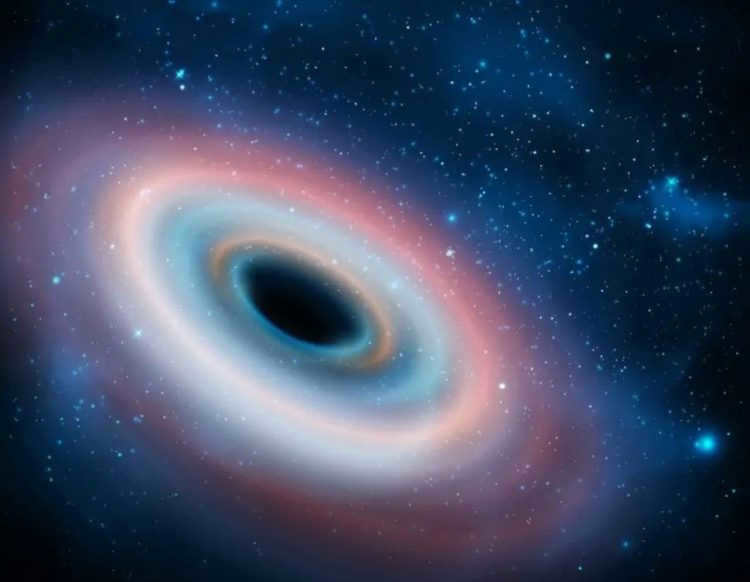
In 2011, astronomers detected an active supermassive black hole weighing 3⋅10 6 M ⊙ in the dwarf galaxy known as Henize 2-10. This galaxy is located 30 million light-years away from the Sun, in the constellation Compass. Researchers also found around 100 active massive black holes in galaxies with relatively low star formation rates. By using longer radio wavelengths, scientists were able to identify 39 potential candidates for less active massive black holes. It is estimated that at least 14 of these candidates are indeed massive black holes.
Interestingly, some of these potential massive black holes are not located at the centers of their galaxies, but rather at the outskirts. Computer simulations suggest that up to half of all dwarf galaxies may contain non-central black holes.
How this applies to people on Earth and if you should consider constructing your own spaceplane.
Another black hole can be detected by observing the path of celestial bodies that pass by. This is exactly what scientists did with Sagittarius A*: they tracked the movement of the star S2 for 10 years, which completed a full orbit around it in just over 15 years. By studying the orbit of this star, researchers concluded that it revolves around a supermassive black hole. This hypothesis was later confirmed through 16 years of observation.
The star S2 is located in close proximity to Sagittarius A*, but it managed to avoid falling victim to its gravitational pull. Similar to other objects, supermassive black holes follow the laws of gravity, allowing stars and even planets to orbit around them. The key is maintaining the appropriate distance.
To access the black hole, an object must approach it closely enough. Currently, no scientific equipment from Earth has made contact with black holes, leaving scientists to only speculate on how it could be achieved.
An artistic representation shows a star collapsing under the influence of tidal forces near a supermassive black hole Roscosmos.
The primary danger of falling into a black hole lies not in the inability to escape, but in what is known as tidal forces. Tidal forces are responsible for the occurrence of tides on Earth, influenced by the Moon and the Sun. In the case of a black hole, these forces are so incredibly strong that they simultaneously stretch and compress any object falling into the black hole in two directions, infinitely increasing their intensity.
There are four main scenarios for the formation of black holes:
- the sudden compression of a massive star;
- The center of the galaxy collapses due to gravitational forces.
- Primary black holes are formed after the Big Bang.
- High-energy nuclear reactions occur.
There is still limited knowledge about the formation of black holes, but scientists can confidently state that the Sun will not transform into one.
The Sun’s mass is insufficient to become a black hole. For a star to become a black hole, it must be at least 2.2 times larger. Therefore, the Sun will eventually become a white dwarf at the end of its life cycle. However, this will only happen billions of years from now, as the Sun is currently only in the middle of its 4.6 billion-year life cycle.
The Russian observatory is equipped with two X-ray telescopes: the German eROSITA and the Russian ART-XC, which is named after M.N. Pavlinsky. These telescopes operate in different X-ray ranges. When observing the vicinity of black holes in the visible range, cosmic dust often obstructs the view, as it absorbs less energetic radiation. The ART-XC telescope, named after M.N. Pavlinsky, can function at energies of up to 30 kiloelectron volts (keV), while the Chandra and XMM-Newton observatories can only operate at energies of up to 10 keV.
The AWG/eROSITA telescope, developed by Gilfanov, Medvedev, Syunyaev, and the Russian eROSITA consortium, has scanned the sky area for the first three weeks, and the resulting data has been represented in an RGB map.
One of the most fascinating inquiries pertains to the evolution of galaxy clusters and the presence of supermassive black holes within many of them. To address this, scientists will conduct separate studies on approximately 100,000 galaxy clusters and around three million supermassive black holes situated at their cores.
Comment removed upon user’s request
Wow, Roscosmos has acquired a presence on TJ. Can’t wait for the Space X advertisements!
Despite any skepticism surrounding Roscosmos, the article is genuinely intriguing. Although, some of the explanations seem to cut off midway through the article.
I highly recommend delving into Kip Thorne’s book, Interstellar: The Science Behind the Scenes.
It is exceptionally well-written.
They’ve also secured a spot on N+1: it seems like the campaign is gaining momentum.
I recently came across this article, perhaps it will pique someone’s interest.
I enjoyed the one about “spaghettification”!
Upon the user’s request, the comment has been removed.
I found it to be quite dark, but this one takes it to a whole new level.
The most important thing is that she got paid. But who will compensate me for my comment? I dedicated 33 seconds of my time!
Comments that lack patriotism won’t receive any payment.
I’ll respond without reading:
1. Absolutely not.
2. It’s definitely worth it.
Is Roscosmos trying to hint at something here? Are we preparing to construct an ark?
Just how much money will we earn? (the hornbill joyfully rubs its hands together).
I greatly appreciate articles like this, thank you.
Hrr hoo, it’s denim.
I’m rewinding the article, next time you have to warn me in advance!
What in the world is a black hole doing inside a planet? Such nonsense. Eat fewer mushrooms.
Self-criticism is quite something.
Roscosmos has made a discovery in space
The most unfortunate thing is that interstellar gas and dust hide the center of the Galaxy from our view. If our eyes were able to see, we would witness a massive gathering of stars that would outshine even the brightest full moon at night.
Moreover, if we could peer through the heart of the Galaxy, we would gain insight into the nature of the Great Attractor. This enigmatic region of the universe possesses a gravitational pull that attracts galaxies within a radius of millions of light years (the most plausible explanation suggests it may be an inconceivably vast cluster of galaxies).
Comment removed as per user’s request
The entire editorial board was completely inoculated.
The article contains glaring scientific errors.
I had doubts that Spectrum-RG would survive even a year, but here it is, already completing its third survey of the sky out of eight. The Lavochniki team has developed a solid platform, learning from the mistakes made with Phobos-Grunt. Sometimes, two wrongs can lead to a right.
A supermassive black hole is a celestial object with a mass ranging from 105 to 1011 times that of our Sun. These colossal black holes reside at the core of many galaxies, including our own Milky Way.
Supermassive black holes captivate our curiosity as they embody extreme forces and phenomena, influencing their surroundings in profound ways. They come in various sizes, with the largest ones weighing billions of times more than our Sun. For decades, it has been widely accepted that every galaxy harbors a supermassive black hole at its center.
Astronomers in the modern era have made a groundbreaking revelation that there exist various types of black holes. These include rotating black holes, electric black holes, and a unique category known as rotating electric black holes. The classification of a black hole is determined by the magnitude of energy it emits while distorting the fabric of space.

Supermassive black holes possess distinct characteristics that set them apart from smaller black holes:
- The average density of a supermassive black hole can be extremely low (even lower than the density of air )
- The gravitational forces near the event horizon are significantly weaker due to the distance between the central singularity and the horizon. As a result, a hypothetical astronaut venturing towards the center of a black hole would not experience the extreme tidal forces until they reach a considerable depth within.
Supermassive black holes distinguish themselves from stellar-mass black holes due to their immense mass and potentially their formation process. A stellar-mass black hole is created from the collapse of a massive star (over 3 solar masses), whereas the formation mechanism of a supermassive black hole remains a mystery.

There are multiple theories regarding the origin of supermassive black holes, but none of them have been definitively proven:
- They may form from regular black holes through the accumulation of mass in regions of the Universe that are rich in dust and gas.
- Another possibility is that they originate from hypothetical medium-mass black holes.
- It is also suggested that they could directly arise from large quantities of gas and dust.
Medium-mass black holes are extremely rare and only a few potential candidates have been identified, which contradicts the expected number of their supermassive counterparts.
A study conducted in February 2017 discovered the presence of intermediate-mass black holes at the center of the massive 47 Tucana cluster.
In 2016, there were indications of a POTENTIAL DISCOVERY of the formation process of a supermassive black hole in the early universe directly from massive gas clouds.
Supermassive black hole activity
Most massive black holes remain relatively dormant, not revealing themselves in any noticeable way. However, a small fraction of them are ravenous monsters that voraciously consume matter, drawing everything that crosses their path into their bottomless abyss. The immense gravitational force causes dust and gas to spiral inward, releasing a tremendous amount of radiation across the entire electromagnetic spectrum as this material meets its demise.
Located 600 million light-years away, the elliptical galaxy Swan A is the nearest galaxy to us and harbors an active black hole at its core.

Scientists have made a groundbreaking discovery using advanced camera technology. They have successfully detected the infrared radiation emitted by the torus surrounding the galaxy. This valuable data has allowed them to closely monitor the behavior of Swan A’s magnetic fields.
Upon comparing this information with data obtained from other observation tools, scientists have made an intriguing finding. The magnetic fields produced by the nuclei of active galaxies function as a massive net, capturing the contents of the torus and drawing it towards the black hole. This, in turn, appears to provide nourishment to the black hole.

Prior to the findings of this research, astronomers primarily focused on the gravitational pull of black holes. However, we now have knowledge that electromagnetism also plays a significant role. By further investigating Swan A and other galaxies, both active and non-active, astronomers aim to comprehend the connection between black holes and magnetic fields.
Concurrently, there is a possibility of understanding why only a small fraction of supermassive black holes exhibit active behavior.
Here are some of the biggest black holes that have been measured to at least a tenfold magnitude. Although this list is not exhaustive, it provides a general sense of the immense and intricate nature of our universe.
The primary black hole within the Phoenix cluster.

The Phoenix Cluster is recognized as one of the largest clusters to exist, with the majority of its mass being composed of dark matter and the intra-cluster environment. Within the central galaxy of this cluster resides a supermassive black hole, which emits a substantial amount of energy into the surrounding system. This black hole is estimated to have a mass that is 20 billion times greater than that of the Sun, and its radius is expected to be approximately 118 billion kilometers.
Through the utilization of data collected by Chandra and various observations made at different wavelengths, it has been determined that this black hole is experiencing rapid growth, expanding at a rate that is 60 times the mass of the Sun each year. However, due to its already significant size, this growth rate is not sustainable, and it is projected that the growth will cease within the next 100 million years.
NGC 4889.
can be rephrased as
The galaxy NGC 4889.

The galaxy NGC 4889, located near the center, shines the brightest. It was first discovered in 1785 and is known as the brightest galaxy in the northern region of the coma cluster. Its average distance from Earth is approximately 308 million light-years.
NGC 4889 harbors one of the largest black holes at its core. This massive black hole heats up the surrounding intracluster environment due to the friction caused by the falling dust and gases. It is estimated to be 5,200 times more massive than the central black hole of the Milky Way and has a weight of around 21 billion solar masses. The event horizon of this black hole spans a distance of 20 to 124 billion kilometers, which is equivalent to 2 to 12 times the diameter of Pluto’s orbit.
APM 08279 + 5255
can be paraphrased as “The astronomical object APM 08279 + 5255”.

In 2002, the observation made by Chandra revealed that gases were being carried away from the supermassive black hole, which powers the quasar APM 08279 + 5255, by high-speed winds. These winds were moving at speeds of up to 40% of the speed of light. The quasar is situated in the constellation Lynx and possesses a brightness that is equivalent to one quadrillionth of the brightness of the Sun. It serves as a prominent source of light across a wide range of wavelengths and has become the subject of extensive research as one of the most distant objects known to us.
The APM 08279 + 5255 supermassive black hole has a weight of 23 billion solar masses (measured through molecular disk velocities). However, a different measurement technique known as reverberation mapping indicates that the black hole has a weight of 10 billion solar masses – a significant difference between the two methods. The gravitational lensing phenomenon, caused by a galaxy that has been captured by the black hole, produces a double image of the quasar. This effect also magnifies the quasar’s light by a factor of 100, allowing for a detailed analysis of its properties despite being located 12 billion light-years away.
Over the past decade, scientists have also made the remarkable discovery that APM 08279 + 5255 contains an astonishing amount of water, equivalent to more than 100 trillion times the Earth’s oceans.
NGC 6166
can be rephrased as
NGC 6166
in English, while preserving the HTML markup.

NGC 6166 is a highly luminous elliptical galaxy situated 490 million light-years away in the Hercules constellation. Approximately 39,000 globular clusters revolve around the galaxy, demonstrating the seamless integration of NGC 6166’s halo with the intracluster environment.
Located at the heart of the galaxy is an immensely massive black hole, boasting a mass 30 billion times that of the Sun. It consumes around 200 solar masses of gas annually, resulting in the formation of expansive relativistic jets. Researchers have proposed the existence of several O-type stars in the galaxy’s center, which are exceptionally rare blue-white stars with temperatures exceeding 30,000 Kelvin.
H1821 + 643
An extremely bright quasar, H1821 + 643 can be found within a massive cluster that emits a significant amount of cooling energy in the Dragon constellation. In 2014, scientists made the groundbreaking discovery that H1821 + 643 possesses one of the largest black holes ever recorded, accurately determining its mass to be an astonishing 30 billion times that of our Sun. This black hole’s event horizon spans a width of 1150 astronomical units (equivalent to approximately 150 million kilometers), while its average density measures 22 grams per cubic meter, which is actually lower than the density of air on Earth.
Additionally, the scientists discovered that the surroundings of the quasar within the cluster of galaxies exhibit notable distinctions – the levels of entropy and temperature are considerably lower and display more pronounced gradients. Recently, an extensive examination of the quasar has provided evidence that our universe contains vast quantities of ionized hydrogen and ionized oxygen.
IC 1101
can be rephrased as follows:
IC 1101
is a massive galaxy located in the constellation Virgo.

IC 1101, which is one of the largest and brightest galaxies in the Universe, is home to a supermassive black hole at its center. This black hole has a mass that is 40-100 billion times greater than that of the Sun. Located 1.04 billion light-years away from Earth, IC 1101 is an elliptical galaxy. It is truly massive, with a mass of approximately 100 trillion stars. Furthermore, this galaxy extends an impressive 2 million light-years from its core.
Similar to other massive galaxies, IC 1101 boasts a significant number of stars that are rich in metals. Among these stars are some that are 11 billion years old and have a beautiful golden yellow color.
S5 0014 + 81
Rephrase the text, making it unique and using the English language while preserving the HTML markup:
S5 0014 + 81

Located near the high declination region of the constellation Cepheus, this blazar is one of the most energetic types of active galactic nuclei. It is situated at a distance of approximately 12.07 billion light-years from Earth. Currently, it holds the 6th position on the list of the brightest known quasars, boasting a brightness that exceeds 10.41W.
To put this into perspective, its brightness is 25,000 times greater than the combined brightness of all the stars in the Milky Way galaxy.
Holm 15A
is a unique celestial object that is located in the universe.

This particular area of space-time can be found within the Holm 15A galaxy, which is situated approximately 700 million light years away from our planet Earth. The central object within the galaxy cluster is a black hole. This region, known as Abell 85, is located within the constellation Kita and is currently recognized as the heaviest region of space-time to have been discovered thus far.
The Abell 85 cluster, which houses the Holm 15A galaxy, is composed of over 500 individual galaxies.
Initially, astrophysicists estimated the mass of the black hole and determined it to be 40 billion times more massive than the Sun.
This particular study was carried out by a team of German scientists hailing from the Munich Observatory and the Max Planck Institute for Extraterrestrial Physics.
Scientists have determined that the formation of supermassive galaxies like Holm 15A occurs when two or more smaller galaxies merge. During this process, the gravitational forces from the center of the newly formed galaxy cause stars to be displaced into radial orbits, leaving behind a black hole. Astrophysicists have observed that with each subsequent merger, the black hole in the galaxy gains mass.
TON 618
TON 618, located 10.37 billion light-years away from Earth, is a hyperluminous quasar that has captured the attention of scientists.
At its core lies a colossal black hole, weighing an astonishing 66 billion times the mass of our Sun.
Discovered in 1957 during a survey of faint blue stars that deviate from the plane of the Milky Way, TON 618 was later identified as a quasar through a more in-depth radio survey conducted in 1970. Scientists believe that TON 618 is comprised of an accretion disk consisting of incredibly hot gas that swirls around the massive black hole situated in the heart of the galaxy. Its luminosity is so intense that it outshines the entirety of the surrounding galaxy.
Supermassive black holes found in small galaxies

In 2011, a dwarf galaxy called Henize 2-10, located 30 million light-years away from the Sun in the constellation Compass, was discovered to have an active supermassive black hole with a mass of 3⋅10^6 M ⊙. Additionally, approximately 100 active massive black holes have been identified in galaxies with relatively low rates of star formation. Subsequent searches using longer radio wavelengths have led to the detection of 39 potential less active massive black holes, with at least 14 of these candidates likely being massive black holes.
Interestingly, some of these potential massive black holes are not located at the centers of their respective galaxies, but rather in the outskirts. Computer simulations have suggested that as many as half of all dwarf galaxies may contain non-central black holes.
Movie
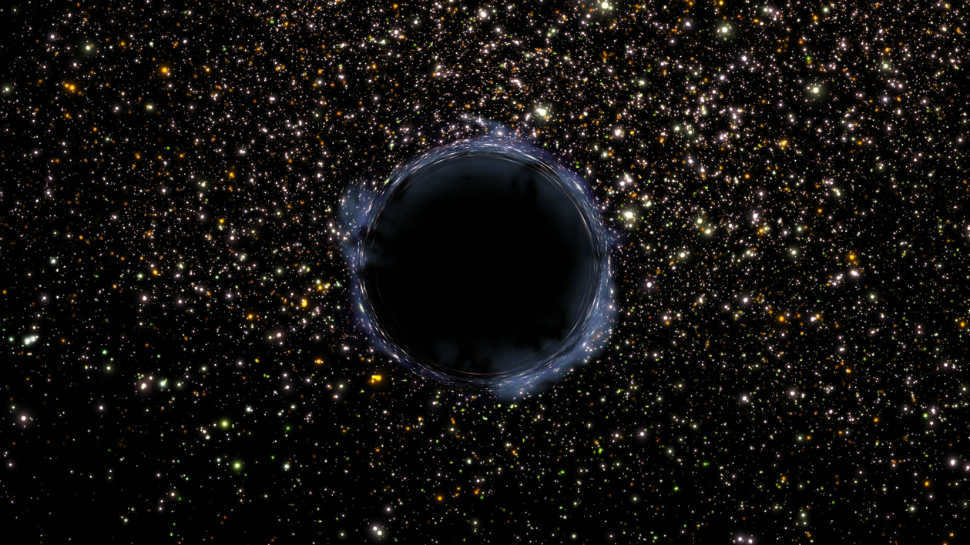
Originally, astronomers were not aware of the presence of such a colossal entity. Their primary objective was to comprehend the peculiar behavior of the nebula they had been observing for an extended period. In contrast to other interstellar nebulae, the gases present (hydrogen cyanide and carbon monoxide) exhibited varying velocities in different regions, and these fluctuations could not be attributed to internal dynamics alone. The nebula spans a diameter exceeding 150 trillion kilometers.
According to Japanese scientists, the identification of a black hole of this magnitude is an extraordinary breakthrough. It is indeed remarkable that astronomers have stumbled upon such a colossal entity for the very first time (excluding the supermassive black hole at the core of the Milky Way, which has already been acknowledged for quite some time). The mass of Sagittarius A* is estimated to be approximately 4 million times that of the Sun.
There are now numerous classifications of black holes, with one category being intermediate-mass black holes. These black holes have larger masses than small stellar-mass black holes (which range from 10 to several tens of solar masses), but smaller masses than supermassive black holes (which range from a million to hundreds of millions of solar masses).
Small black holes are formed when stars collapse under their own gravity. It is estimated that there are about 100 million of these objects in the Milky Way. Medium-mass black holes form in a similar way. However, the formation and evolution of supermassive black holes, such as Sagittarius A*, were previously unknown.
What will be the fate of the discovered black hole in the future? As per the findings of Japanese scientists, it is undergoing a gradual movement towards the core of the Milky Way and is expected to eventually merge with Sagittarius A*. This merger will result in a significant increase in the mass of the black hole at the center of our galaxy. Continual observation of the gas nebula encompassing the black hole is being carried out by experts to further analyze earlier collected data, thereby shedding light on the origins of this celestial object. In the coming period, the Japanese researchers will be dedicated to this very task.
Located in the heart of the Milky Way galaxy lies a fascinating area known as the Sagittarius A* black hole. This region is not only a hub for celestial bodies orbiting around it, but also serves as a sanctuary for a supermassive black hole of immense proportions, surpassing the mass of our sun by millions of times. The revelation of its existence has shed light on the presence of comparable entities within the central regions of expansive spiral and elliptical galaxies.
